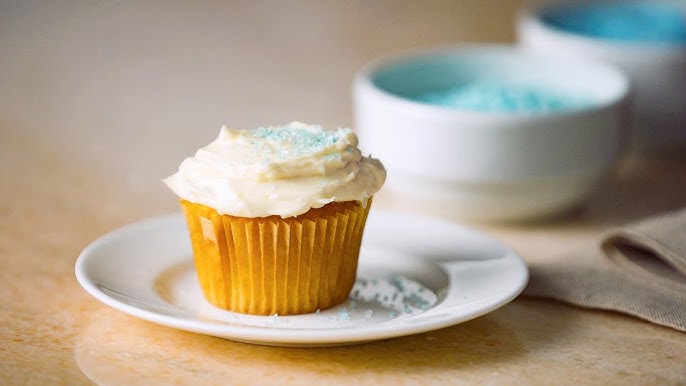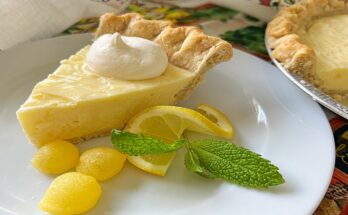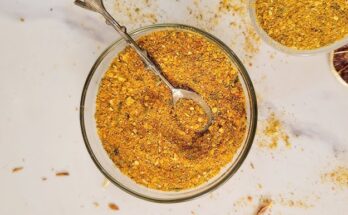Buttercream Icing Recipe: Buttercream icing is a smooth, creamy, and rich frosting that’s a staple in the world of baking. Perfect for cakes, cupcakes, and cookies, it’s loved for its versatile texture and ability to be easily flavored and colored.
Whether you’re baking for a birthday party or just a weekend treat, buttercream can take your dessert to the next level. It’s easy to make, but with a few variations, you can achieve different styles, including American, Swiss, Italian, and French versions.
Ingredients Required for Buttercream Icing
To create a basic buttercream icing, you’ll need the following:
Basic Ingredients:
- Unsalted butter (softened) – 1 cup (2 sticks)
- Powdered sugar (sifted) – 4 cups
- Vanilla extract – 1 teaspoon
- Milk or heavy cream – 2-4 tablespoons
Optional Ingredients:
- Cocoa powder for chocolate flavor
- Almond or lemon extract for different flavors
- Gel food coloring for vibrant hues
These simple ingredients combine to create a decadent and spreadable frosting. You can also customize the flavor to match any dessert.
Types of Buttercream Icing
There are various types of buttercream, each with its unique texture and flavor.
- American Buttercream: The easiest and most popular type. It’s rich, sweet, and only requires butter, powdered sugar, vanilla, and milk.
- Swiss Meringue Buttercream: Silky and less sweet, this involves whipping egg whites and sugar before adding butter.
- Italian Buttercream: Similar to Swiss but requires a hot sugar syrup, making it stable and luxurious.
- French Buttercream: Made with egg yolks, it’s rich and velvety with a custard-like flavor.
For this guide, we’ll focus on the classic American buttercream.
Tools and Equipment Needed
To make buttercream icing, you’ll need the following tools:
- Electric Mixer: A stand mixer or hand mixer speeds up the process and ensures a smooth consistency.
- Mixing Bowl: A large bowl to prevent splatter when mixing.
- Rubber Spatula: Helps scrape down the sides of the bowl.
- Measuring Cups and Spoons: For precise measurements of your ingredients.
- Sifter: Optional, but helpful to remove lumps from powdered sugar.
These tools make the process easier, though you can still manage with minimal equipment if necessary.
How to Make Buttercream Icing – Step by Step Guide
Step 1: Preparing Your Ingredients
Before you start, it’s essential to prepare all your ingredients. Accurate measuring is key to the perfect buttercream.
- Soften the Butter: Take the butter out of the fridge at least 30 minutes before starting. It should be soft but not melted.
- Sift the Sugar: Sifting removes any lumps from powdered sugar, ensuring a smoother icing.
Pro tip: Room-temperature butter mixes more easily and helps create a light, fluffy buttercream. If your butter is too cold, the icing will have a chunky texture.
Step 2: Creaming the Butter
This step is where the magic begins! Add your softened butter to a large mixing bowl.
- Beat on Medium Speed: Use an electric mixer to whip the butter for about 3-4 minutes until it’s light and fluffy.
- Scrape Down the Bowl: Use a spatula to ensure all the butter is evenly creamed.
Properly creamed butter creates a smoother base, which helps the powdered sugar blend seamlessly. Over time, you’ll notice the butter turning pale, indicating that it’s been aerated correctly.
Step 3: Gradually Adding Powdered Sugar
Now it’s time to sweeten things up!
- Add Sugar in Batches: Add one cup of powdered sugar at a time, beating on low speed to prevent a sugar cloud.
- Increase Speed: Once incorporated, increase the speed to medium and mix until smooth.
- Repeat: Continue adding the remaining sugar in batches, scraping the bowl as needed.
Mixing gradually ensures that the buttercream doesn’t become overly dense or grainy. Patience is key here!
Step 4: Adding Liquid Ingredients
After your sugar and butter are fully combined, it’s time to add liquid ingredients.
- Start with 2 Tablespoons: Add milk or cream and vanilla extract to the mixture.
- Check the Texture: If the frosting feels too thick, add more liquid one tablespoon at a time.
The goal is a spreadable, yet sturdy consistency. The liquid helps balance the sweetness and allows the buttercream to glide smoothly over your baked goods.
Step 5: Flavoring the Buttercream
This is where you can get creative!
- Classic Option: Add vanilla extract for a traditional flavor.
- Alternative Flavors: Try almond extract, citrus zest, or cocoa powder for a twist.
- Mix Thoroughly: Blend the flavoring evenly throughout the frosting.
Experimenting with flavors can make each dessert feel unique and personalized.
Step 6: Achieving the Perfect Consistency
Consistency is everything when it comes to buttercream icing. Whether you’re piping decorative swirls on cupcakes or spreading it evenly on a cake, the texture has to be just right.
- For Stiffer Buttercream: If the icing is too thin, add more powdered sugar (a tablespoon at a time) until the desired thickness is achieved.
- For Softer Buttercream: If it’s too thick, add a splash of milk or cream. Be cautious—only add a small amount at a time to avoid making it runny.
- Mixing Time: Beat the mixture on medium-high speed for another 2-3 minutes to incorporate air for a fluffy texture.
The final result should be smooth, creamy, and able to hold its shape without being overly stiff.
Step 7: Coloring the Buttercream
Adding color can transform your buttercream, making your desserts stand out at any event.
- Choose the Right Food Coloring: Gel-based food colorings are ideal as they provide vibrant color without affecting the consistency of the frosting.
- Add Gradually: Start with a small amount of coloring and mix thoroughly. You can always add more, but you can’t take it out!
- Blend Evenly: Use a spatula to scrape the sides of the bowl and ensure the color is consistent throughout.
If you’re aiming for multiple colors, divide the buttercream into separate bowls and color each batch individually.
Step 8: Storing and Preserving Buttercream
Sometimes, you might want to make your buttercream ahead of time or store leftovers. Proper storage will keep it fresh and ready to use.
- Room Temperature: If you’re using it the same day, you can leave buttercream out at room temperature for up to 8 hours, as long as it’s not too hot or humid.
- Refrigeration: Store buttercream in an airtight container in the refrigerator for up to one week. Before using, allow it to come to room temperature and re-whip it to restore the fluffy texture.
- Freezing: Buttercream can be frozen for up to 3 months. Thaw in the fridge overnight, then bring it to room temperature and whip it again before use.
These storage tips help ensure your buttercream remains smooth and delicious whenever you need it.
Common Mistakes to Avoid
Even seasoned bakers can make mistakes with buttercream. Here are some common issues and how to fix them:
- Overbeating: Too much mixing can cause the buttercream to become airy and separated. If this happens, add a little more milk and beat on low speed.
- Undermixing: If you don’t cream the butter long enough, the frosting may have a grainy texture. Always beat until smooth and fluffy.
- Wrong Ingredient Ratios: Using too much or too little sugar can ruin the consistency. Stick to the recipe measurements, but adjust as needed based on texture.
Avoiding these mistakes will save you time and frustration, ensuring that your icing turns out perfect every time.
Decorating with Buttercream Icing
Now that your buttercream is ready, it’s time to decorate! Whether you’re a beginner or a pro, these techniques will help elevate your designs.
- Basic Spread: Use an offset spatula to evenly spread the buttercream over cakes and cupcakes.
- Piping: Fit a piping bag with your favorite tip (like a star or round tip) to create decorative swirls, flowers, or borders.
- Smoothing: For a polished look, use a bench scraper to smooth the sides of a frosted cake.
Practice makes perfect—don’t be afraid to experiment and find your own style!
Tips and Tricks for the Perfect Buttercream Icing
Here are some expert hacks to take your buttercream to the next level:
- Add a Pinch of Salt: A small amount of salt can balance the sweetness and enhance the flavor.
- Use High-Quality Ingredients: Real butter, pure vanilla extract, and fresh cream make a noticeable difference in taste.
- Cool Cakes Completely: Never apply buttercream to a warm cake. The heat will melt the frosting and ruin your design.
- Chill for Sharp Edges: If you’re creating sharp edges or intricate designs, chill the frosted cake for 15-30 minutes to firm up the icing.
These tips can help you achieve professional-looking results every time you bake.
Nutritional Information (Optional)
Here’s a general overview of the nutrition in buttercream icing:
| Nutrient | Per Serving (2 tbsp) |
|---|---|
| Calories | ~150 |
| Fat | 10g |
| Sugar | 18g |
| Protein | 0g |
| Carbohydrates | 20g |
Keep in mind that these values may vary depending on the specific ingredients used.
FAQs about Buttercream Icing Recipe
1. What ingredients do I need for buttercream icing?
For a basic buttercream icing, you will need unsalted butter, powdered sugar, milk or heavy cream, and vanilla extract. Some variations may include salt, food coloring, or different flavors.
2. How long does it take to make buttercream icing?
Buttercream icing can be made in about 15 minutes. This includes the time to soften the butter and blend the ingredients to achieve a smooth, creamy texture.
3. Can buttercream icing be made in advance?
Yes, buttercream icing can be made in advance. It can be stored in the refrigerator for up to one week or in the freezer for several months. Be sure to let it reach room temperature and re-whip it before using to restore its creamy texture.
4. Is buttercream icing suitable for piping and decorating?
Absolutely! Buttercream icing is ideal for piping and decorating. Its smooth, malleable texture makes it perfect for creating intricate designs on cakes and cupcakes.
5. How can I color buttercream icing?
You can color buttercream icing using gel food coloring, which is preferable because it is highly concentrated and won’t thin out the icing. Add the coloring a little at a time until you achieve the desired shade.
6. What should I do if my buttercream is too runny or too stiff?
If your buttercream icing is too runny, add more powdered sugar to thicken it. If it’s too stiff, add a small amount of milk or cream until it reaches the desired consistency.
7. Can buttercream icing be used under fondant?
Yes, buttercream icing is often used as a base layer under fondant. It helps the fondant adhere to the cake and provides a smooth surface for a neat appearance.
8. How do I store a cake with buttercream icing?
A cake with buttercream icing should be stored in a cool place, away from direct sunlight. For longer storage, refrigerate it. Just be sure to cover it well to prevent absorption of other food odors.
9. Can I use margarine instead of butter in buttercream icing?
While you can use margarine, butter is recommended for the best flavor and texture. Margarine may alter the taste and stability of the icing.
10. Are there any dairy-free alternatives for buttercream icing?
For a dairy-free version, you can substitute the butter with vegan butter and use a plant-based milk. This will give you a similar texture and can be just as delicious.
Conclusion
Buttercream icing is a versatile, easy-to-make frosting that can elevate any dessert. With just a few basic ingredients and some simple steps, you can create a smooth, fluffy icing that’s perfect for spreading, piping, and decorating. Don’t be afraid to experiment with flavors, colors, and textures to make your desserts truly unique.
Whether you’re a beginner or a seasoned baker, mastering buttercream is a must-have skill in your baking toolkit. Now it’s time to get creative—happy decorating!



